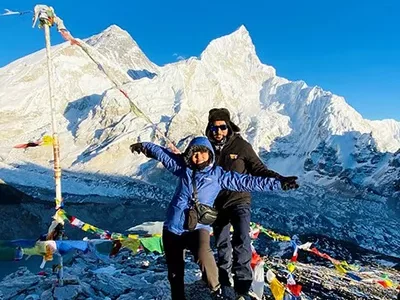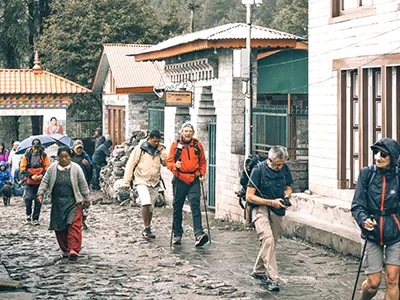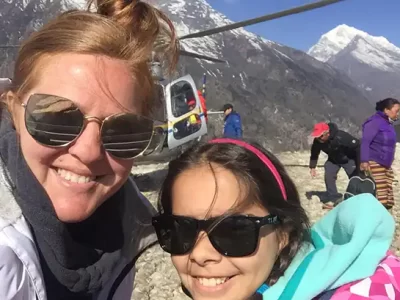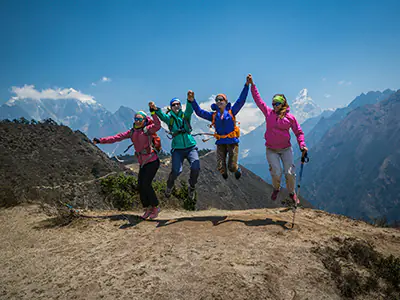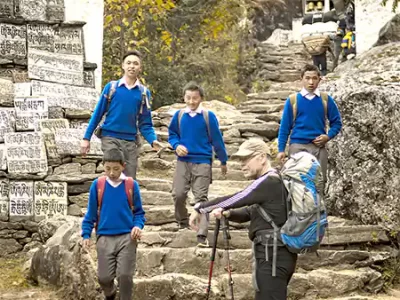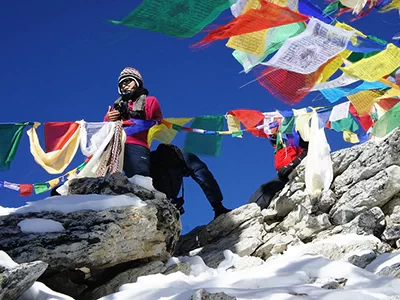Imagine a massive river of ice sculpted over countless years by snow’s constant accumulation and compression. A glacier is a force of nature that carves through mountains, creating breathtaking landscapes.
High in the Himalayas, the Khumbu Glacier reigns supreme, a testament to nature’s raw power and beauty. This iconic glacier is a vital part of the Everest region, drawing trekkers and mountaineers from all corners of the Earth.
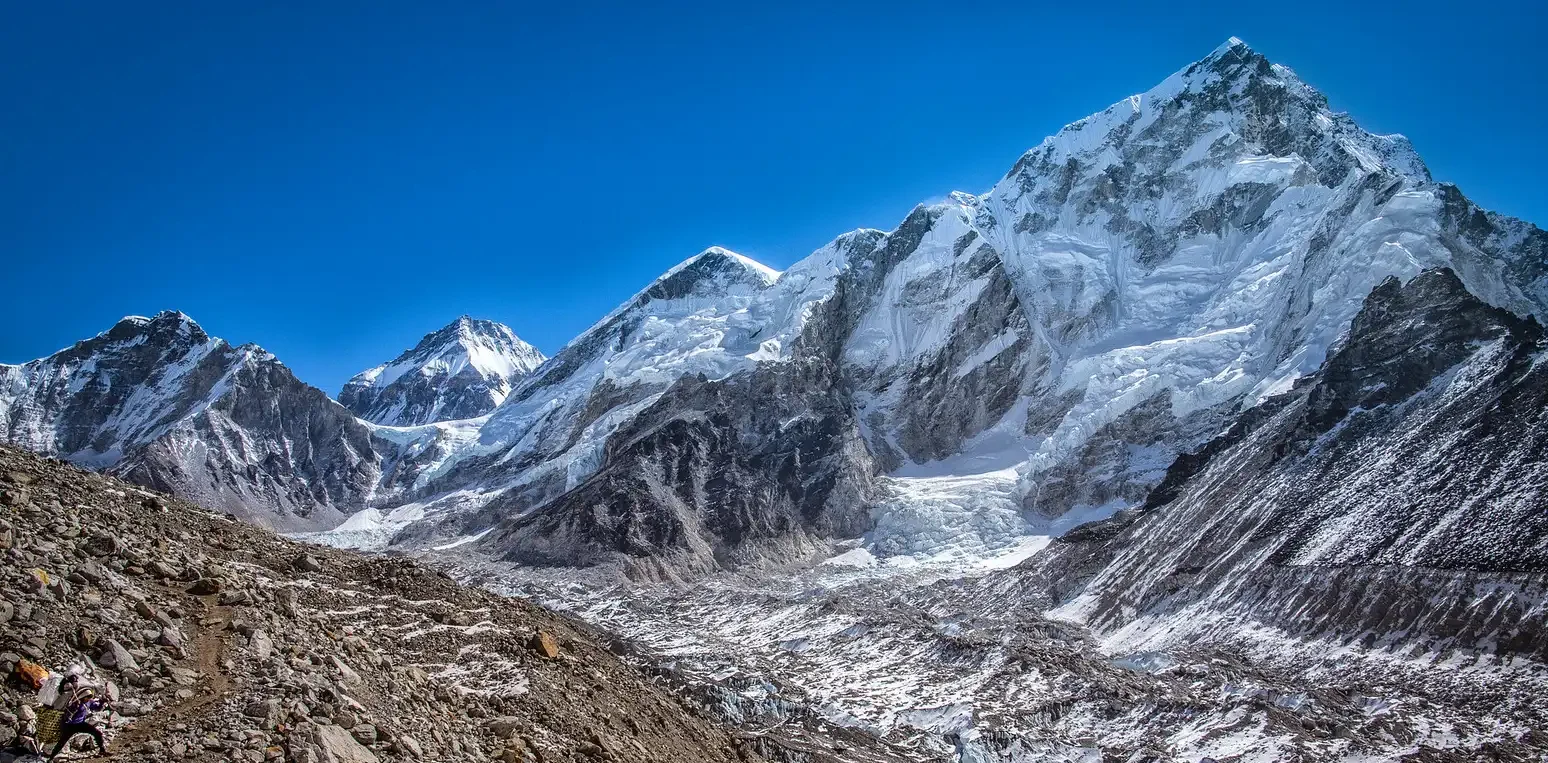
The Khumbu Glacier is far from static; it’s a living, breathing entity in constant flux. Shifting ice towers, deep crevasses, and cascading icefalls shape a challenging yet awe-inspiring terrain. Navigating this icy landscape is an exhilarating adventure that adds a unique layer to any Everest expedition.
Highlights of the Khumbu Glacier
- Khumbu Icefall: The First Challenge: The Khumbu Icefall Everest presents the first major hurdle to reaching the peak. It’s a chaotic maze of massive ice blocks constantly shifting and tumbling. Crossing this formidable obstacle demands technical skill and meticulous route planning.
- Where to Find It: The Glacier Khumbu is located in the Khumbu region of Nepal. It stretches from the foot of Mount Everest to the base of the Lhotse-Nuptse ridge, forming a crucial part of the South Col route, the most popular way to summit Everest.
- Trekking the Glacier: The glacier isn’t just for climbers; it’s also a popular trekking destination. Explore the Khumbu region on the Everest Base Camp trek and enjoy spectacular views of the glacier and its majestic peaks.
- A Changing Landscape: Climate change threatens the Glacier Khumbu, like many others worldwide. Rising temperatures are causing it to melt at an alarming pace, raising concerns about its future and the impact on the surrounding environment.
Everest Base Camp Trek
Luxury Everest Base Camp Trek
Everest Base Camp Trek with Helicopter Return
Where is Khumbu Glacier?
Picture this: The Khumbu Glacier, a majestic river of ice winding its way through the heart of the Himalayas. You’ll find it in the Khumbu region of Nepal, nestled between the world’s tallest peak, Mount Everest, and the imposing Lhotse-Nuptse ridge. It’s a truly awe-inspiring location!
Imagine the glacier snaking down from the Western Cwm, a high-altitude valley near Everest’s summit, carving its path through the rugged landscape. It stretches for about 12 kilometers before finally reaching its end at a height of 4,900 meters.
Landmarks that Shape the Khumbu Glacier
- Mount Everest: The glacier’s trek begins in the Western Cwm, a valley between Everest and the Lhotse-Nuptse ridge. This proximity to the world’s highest peak makes it a key landmark for mountaineers aiming for the summit.
- Lhotse-Nuptse Ridge: This towering ridge creates the southern border of this place, adding a dramatic backdrop to the already breathtaking glacial scenery.
- Khumbu Icefall: At the glacier’s western end lies the Khumbu Icefall, a chaotic jumble of ice blocks. Climbers taking the South Col route to Everest’s peak face significant challenges.
- Everest Base Camp:
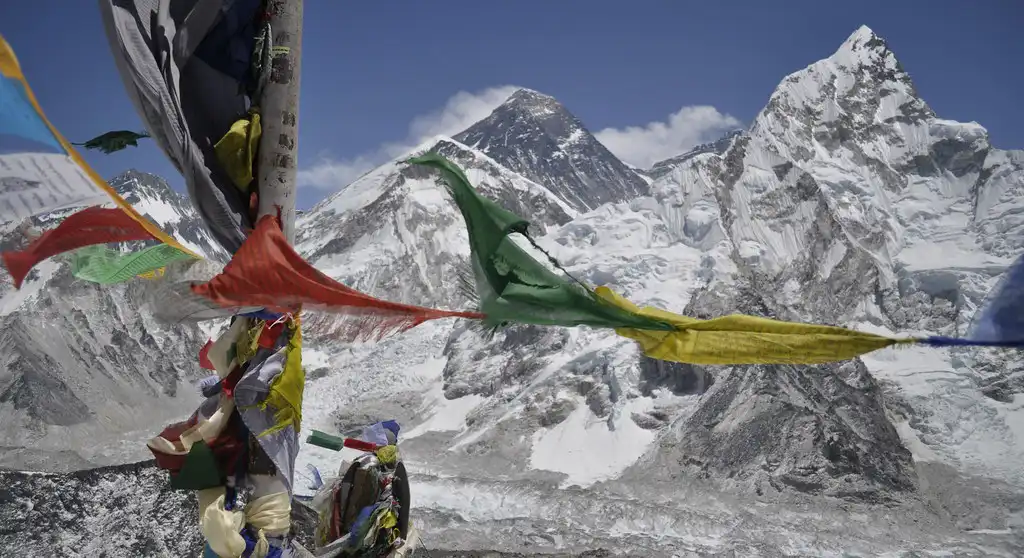
Though not directly on the glacier, the famous Everest Base Camp sits at its edge, giving trekkers a front-row seat to this icy giant.
Finding Your Way on the Khumbu Glacier
A Khumbu Glacier map is your best friend if you’re venturing into this region. It details the glacier’s topography, including the location of the Khumbu Icefall, crevasses, and other potential hazards.
Scientific and Geological Importance
The Khumbu Glacier isn’t just a feast for trekkers and climbers’ eyes; it’s a goldmine for scientists and geologists. This icy giant offers a unique peek into Earth’s past, present, and future.
How It Formed and Moves: A Story Told in Ice
Like all glaciers, the Khumbu Glacier was born from countless years of snow accumulation. Snowflakes compact and transform into solid ice under their weight. Gravity then takes over, pulling this enormous ice sheet downhill and carving its way through the mountains.
But the Glacier Khumbu isn’t frozen in time. It’s a dynamic river of ice, always on the move, even at a snail’s pace. It creeps downwards several meters each year. This movement is responsible for the glacier’s unique features, like deep cracks, towering ice blocks (seracs), and the impressive Icefall.
Research on the Glacier: Unraveling Climate Change
The Khumbu Glacier is a hot spot for climate change research. Scientists delve into its ice cores, which hold trapped air bubbles and dust particles from bygone eras. These act like a time capsule, revealing changes in temperature, the atmosphere, and even past volcanic eruptions.
Recent studies, however, tell a worrying tale. Like many others across the globe, the Glacier Khumbu is melting at an alarming rate because of rising temperatures. The consequences of this are far-reaching:
- Sudden Floods: Melting ice can form glacial lakes, which, if they burst, can cause devastating floods downstream.
- Water Shortages: The Khumbu Glacier feeds into rivers that millions rely on for water. Its shrinking size could disrupt water supplies, impacting agriculture and hydropower.
- Ecological Upheaval: The glacier’s meltwater supports a fragile ecosystem. If it disappears, habitats could change dramatically, threatening the survival of many species.
A Living Laboratory
By studying the Glacier Khumbu, scientists gain invaluable insights into the effects of climate change. This knowledge is critical for creating strategies to lessen its impact and safeguard vulnerable communities and ecosystems.
The glacier also serves as a real-world classroom for aspiring glaciologists and climate scientists. Research here adds to our global understanding of glaciers and helps us predict how they might react to future climate changes.
Everest Base Camp Trek for Beginners
Everest Panorama Trek
Everest High Pass Trek
Khumbu Icefall: The Treacherous Gateway to Everest
Nestled at the head of the Khumbu Glacier, the Khumbu Icefall stands as a formidable challenge for those aspiring to summit Mount Everest.
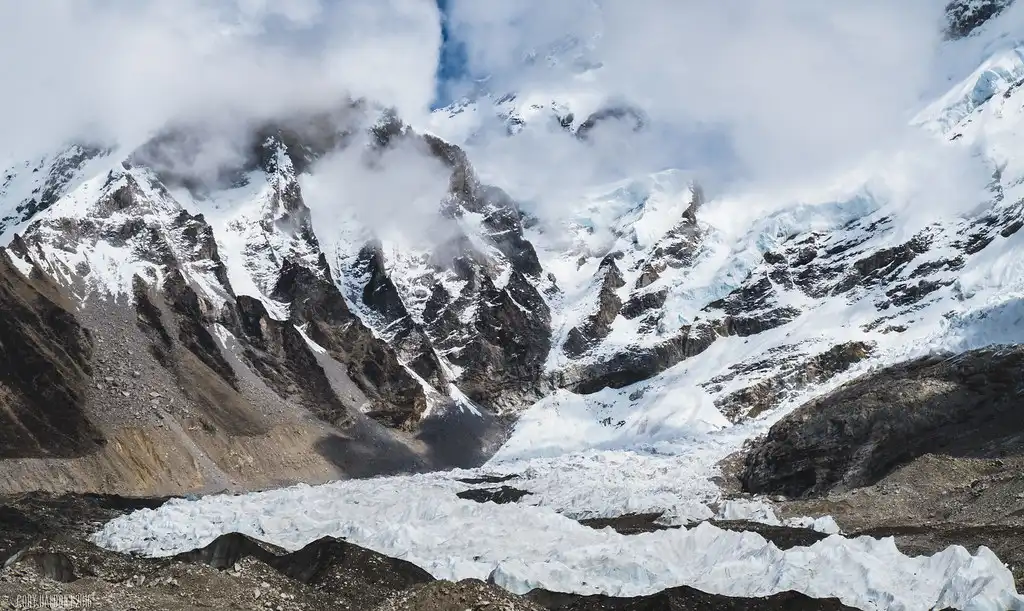
This dynamic and ever-changing section of the glacier is notorious for its towering ice seracs, deep crevasses, and unpredictable avalanches.
Significance for Climbers
This Icefall is the first significant obstacle climbers encounter on the popular South Col route to Everest’s summit. Its significance lies not only in its physical challenges but also in its strategic location.
- Gateway to the Western Cwm: The Icefall serves as the gateway to the Western Cwm, a high-altitude valley that leads climbers further up the mountain toward the summit.
- Technical Challenge: Navigating this Icefall requires technical climbing skills, including ropes, ladders, and ice axes. Climbers must prepare to traverse treacherous ice formations, cross deep crevasses, and navigate around unstable seracs.
- Time Factor: Crossing the Icefall can be a time-consuming endeavor. Depending on the conditions, navigating this complex terrain can take several hours or even a day.
- Risk and Reward: Despite its inherent dangers, this Icefall is unavoidable in the Everest climbing experience. It represents a test of physical and mental fortitude, and successfully navigating it is a significant milestone on the trek to the summit.
Navigating the Icefall
- Experienced Guides: Climbers rely on experienced Sherpas and guides familiar with the Khumbu Icefall’s ever-changing conditions. These experts establish routes, fix ropes, and support climbers.
- Early Morning Starts: Climbers often start their ascent in the early morning when the ice is more stable, and the risk of avalanches is lower.
- Constant Vigilance: Conditions in the Icefall can change rapidly. Climbers must remain alert and adapt to new challenges as they arise.
- Respect for the Mountain: The Khumbu Icefall is a powerful reminder of the forces of nature. Climbers must approach it respectfully and humbly, recognizing the inherent risks and the importance of teamwork and preparation.
Khumbu Glacier: A Trekker’s Paradise and Conservation Challenge
The Khumbu Glacier offers diverse experiences, from the awe-inspiring beauty witnessed by trekkers to the formidable challenges climbers face.
Trekkers’ Perspective
- Scenic Beauty: The Everest Base Camp trek rewards trekkers with awe-inspiring vistas of the Glacier Khumbu. The vast expanse of ice, surrounded by towering peaks, creates an unforgettable panorama.
- Altitude Acclimatization: Trekking at high altitudes demands careful acclimatization. It’s essential to ascend gradually, allowing your body to adjust to the thin air.
- Cultural Immersion: The Khumbu region is home to the Sherpa people, renowned for their mountaineering expertise and warm hospitality. Interacting with the local communities adds a rich cultural dimension to the trek.
Climbers’ Perspective
- Khumbu Icefall Challenge: This Icefall is a significant hurdle to Everest’s summit. Its constantly shifting ice formations require technical climbing skills and nerves of steel.
- Sherpa Support: Sherpas play a vital role in Everest expeditions. They establish routes through the Icefall, carry supplies, and provide invaluable support to climbers.
- Weather and Altitude: Extreme weather and the harsh conditions of high altitude, such as low oxygen levels and the risk of altitude sickness, challenge climbers.
Safety Considerations
- Acclimatization: Gradual ascent and proper acclimatization are crucial to avoid altitude sickness.
- Experienced Guides: Hiring experienced guides and Sherpas is essential for safely navigating the Khumbu Glacier and Icefall.
- Proper Equipment: Climbers and trekkers need appropriate gear, including warm clothing, sturdy boots, and, for climbers, technical climbing equipment.
- Respect for the Mountain: The Khumbu region is a fragile environment. It’s essential to minimize your impact and follow Leave No Trace principles.
Conservation Efforts
Like many others worldwide, the Glacier Khumbu faces the threat of climate change. Rising temperatures are causing rapid melting, impacting the environment and local communities.
- Glacier Monitoring: Scientists research the Glacier Khumbu to understand its changes and predict future impacts.
- Waste Management: Efforts are underway to improve waste management in the Everest region, including initiatives to reduce, reuse, and recycle.
- Sustainable Tourism: Promoting responsible tourism practices helps minimize the negative impact of visitors on the fragile ecosystem.
- Community Engagement: Conservation efforts heavily rely on the involvement of local communities. They are involved in initiatives to protect the environment and promote sustainable livelihoods.
Balancing Tourism and Conservation
The Khumbu Glacier’s allure attracts thousands of visitors each year. While tourism provides economic benefits, it’s essential to manage it sustainably to protect the glacier and its surrounding environment for future generations.
Seeing is Believing: Khumbu Glacier Map
The Khumbu Glacier is a sight to behold, but a visual aid is invaluable for appreciating its grandeur and genuinely understanding its complexities. A Glacier Khumbu map offers a bird’s-eye view of this icy giant, highlighting its key features and surrounding landmarks.
- Orient Yourself: The map pinpoints the glacier’s location concerning Mount Everest, the Lhotse-Nuptse ridge, and other notable peaks. This perspective helps you grasp the scale and context of the massive ice formation.
- Navigate the Terrain: The map details the glacier’s topography, including the treacherous Khumbu Icefall, crevasses, and potential routes for trekkers and climbers. This knowledge is essential for safe navigation.
- Identify Landmarks: The map highlights key landmarks like Everest Base Camp, the Western Cwm, and the various climbing camps, providing a visual reference for your adventure.
Images and Videos: Bringing the Khumbu Glacier to Life
While a map offers a practical understanding, photos, and videos capture the Khumbu Glacier’s raw beauty and power.
- Dramatic Ice Formations: Witness the towering seracs, deep crevasses, and cascading icefalls that make the Khumbu Icefall both a challenge and a marvel.
- Scenic Vistas: Experience the breathtaking panorama of the glacier as it winds its way through the Himalayan landscape.
- Human Endeavor: See climbers navigate the Icefall, showcasing their courage and determination in the face of nature’s challenges.
Where to Find Visual Resources
- Online Resources: Numerous websites and online platforms offer Khumbu Glacier maps, photos, and videos. A simple online search will produce an abundance of visual content.
- Trekking and Climbing Companies: Many companies that organize treks and expeditions to the Everest region provide their clients with detailed maps and visual resources.
- Guidebooks and Publications: Guidebooks and publications dedicated to the Everest region often include maps and photographs of the Khumbu Glacier.
Visitor Information: Plan Your Khumbu Adventure
The Khumbu Glacier beckons adventurers worldwide with its breathtaking scenery and unique challenges. Whether you’re a seasoned trekker or a first-time visitor, here’s some practical advice to help you plan your trip:
Best Time to Visit
- Spring (March-May): Clear skies, mild temperatures, and blooming rhododendrons make spring an ideal time to visit. The Everest climbing season also falls during this period, adding excitement to the region.
- Autumn (September-November): Autumn (September-November) is another popular season, boasting stable weather and clear views. While spring brings larger crowds, autumn boasts smaller visitor numbers and stunning fall colors.
Gear Recommendations
- Trekking: Sturdy hiking boots, warm layers, waterproof jackets and pants, sunglasses, sunscreen, and a hat are essential. Trekking poles can also be helpful, especially on steep descents.
- Climbing: If you plan to tackle this Icefall or venture higher, you need specialized climbing gear, including crampons, an ice axe, a harness, and ropes.
Nearby Attractions
- Everest Base Camp: A popular destination for trekkers, offering stunning views of the Khumbu Glacier and surrounding peaks.
- Kala Patthar: A viewpoint that provides panoramic views of Everest and the Khumbu Icefall.
- Namche Bazaar:
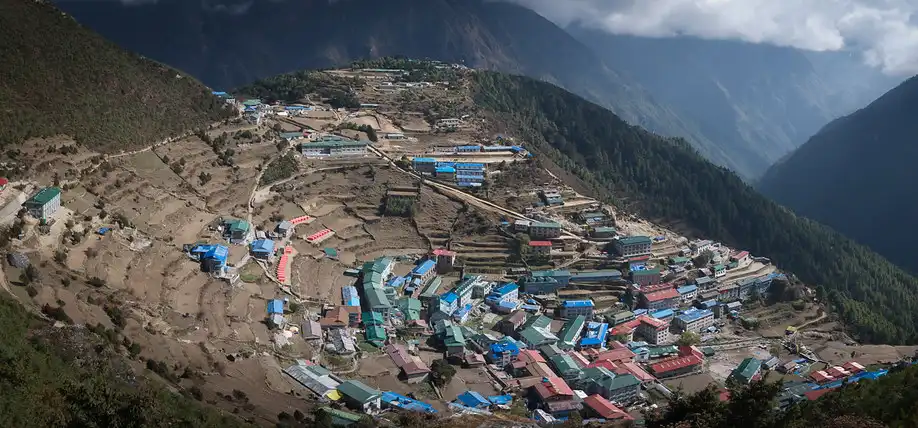
A vibrant Sherpa village with traditional architecture, shops, and restaurants.
- Tengboche Monastery: The historic Tengboche Monastery, perched high in the mountains, provides visitors with stunning views of Everest.
Additional Tips
- Acclimatization: Take your time to acclimatize to the high altitude.
- Experienced Guides: Hire local guides or Sherpas for safe navigation and cultural insights.
- Respect the Environment: Practice responsible tourism and minimize your impact on the fragile ecosystem.
Conclusion: A Natural Wonder and a Lifeline
The Khumbu Glacier is far more than just a scenic wonder. As a cornerstone of the Everest ecosystem, it molds the terrain and provides essential water resources. It also plays a crucial role in local tourism, attracting thousands of visitors annually.
However, glaciers are under threat from climate change. Its rapid melting is a stark reminder of the environmental challenges we face. As visitors, we minimize our impact and support conservation efforts. By doing so, we can help preserve this natural treasure for future generations to experience and appreciate.

